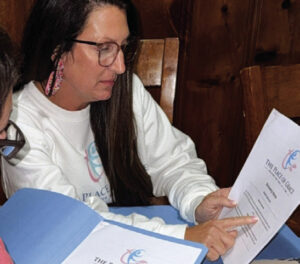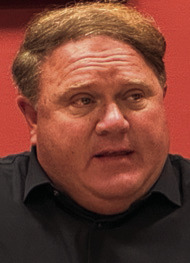Spinning yarns: Robin Swindle, Phil Campbell spinner, tells her story
FRANKLIN LIVING—
Robin Swindle’s love of working with yarn started more than 20 years ago, when she bought an illustrated book and used it to teach herself how to crochet. These days, she still crochets but also knits, weaves on a loom and spins her own yarn using a spinning wheel.
HOW IT STARTED
The desire to take up spinning began with concerns about having enough yarn on an ongoing basis. “During the beginning of the pandemic, I got worried the stores might run out of yarn,” explained Swindle, “and I started Googling and found out people still make handspun yarn, so I set about learning how.”
While on vacation in Gatlinburg in November 2020, she discovered the Smoky Mountain Spinnery, a large specialty store for those creating all types of fiber arts. “I could spend all day in there,” said Swindle. “As soon as I walked in, I knew it was precisely my kind of place.”
She started looking for a drop spindle, an inexpensive way many beginners start to learn how to spin yarn, and she wound up selecting one with a dragonfly because that’s her favorite insect. After a 10–15 minute in-store lesson on how to make yarn using the drop spindle, she said it was pretty much a matter of practice. “I just had to keep going with it. I was ‘bit by the bug’ right away, and I fell down all the rabbit holes.” She is mostly self-taught, using books and YouTube videos.
SPINNING WHEEL
Swindle said she soon saw the limitations of working with only a drop spindle for spinning and realized she wanted a spinning wheel. She began digging deep into research about the different types and costs. “Some of them are quite expensive, but I just kept looking,” she explained. “During the February ice storm last year, I found the one I ended up getting, a Saxon-type spinning wheel. I bought it through Facebook Marketplace from a lady in Arkansas.”
One feature of the wheel holds special significance for Swindle. Her father had passed away from multiple myeloma within the previous two or three weeks, and the date of manufacturing on the bottom of the wheel is his birthday in the year she was born.
FIBER QUALITIES AND TYPES
Swindle said different fibers have varying qualities, and that makes each one more desirable for certain types of projects than others. While unsure whether she has a favorite, Swindle said plain wool is the easiest to work with, as well as the most versatile.
“Some wools are softer than others, and some are very coarse. A lot of people use those for making rugs,” she explained. “Wool can be spun thin or thick, and a lot of people spin it into ‘art yarn’ – leaving bits of a curly lock hanging out and just having one end spun in. A lot of weavers use art yarn because it’s more textured and adds an aesthetic many find desirable.”
She said some people use just the roving, which is when wool has been combed and fibers are straightened out, choosing to knit or weave with it.
In contrast, spun silk “tends to want to be thinner yet doesn’t come apart well so that it can be spun thinner.”
Flax – called linen once it’s woven – is a dry fiber, a quality that is not as desirable because the fibers don’t stay together as well. Swindle said some wheels have attachments to hold a bowl of water to help when working with very dry fibers.
The most unusual fibers she has worked with include camel and yak.
Swindle explained she found a company, Paradise Fibers, that has a monthly fibers club, which she looks forward to as a good way to try spinning different types of fibers into yarn.
GETTING TO WORK
Swindle explained some fibers have crimp, a sort of “memory.” She described it as having a similar quality as curly hair, which can be straightened but goes back to its naturally curly state when washed. “Yarn with crimp holds together better. Wetting the yarn, ‘setting the twist,’ after fibers with crimp are spun into yarn, helps them hold together better.”
Fibers that don’t have enough crimp might work when used on their own but would not be at their best without blending with fibers that do have crimp. Different types of fibers can be spun into a blended yarn, a technique Swindle sometimes uses in her work. This helps to combat less desirable qualities, like being overly dry. “Some fibers need to be blended,” Swindle said. “One lady I know of uses fiber from a Himalayan cat, and a lot of people spin dog hair. Some use a certain type of alpaca fiber.”
Choosing the best fiber really depends on the project. “Angora fibers wouldn’t work with a wool hat or anything that needs to hold its shape because they don’t have crimp, and they tend to stretch, but they would be great for a scarf.”
Swindle also goes through the processes of dyeing some of the fibers she spins into yarn, which adds another degree of originality to her work. “Protein fibers (anything that’s animal fur or silk) need heat and acid to be dyed,” explained Swindle. “I use food coloring gels, but many people buy commercial dyes; however, for centuries, natural dyes, like parts of plants and vegetables and even coffee and tea have been used.”
Swindle said flax, cotton, bamboo and other baste fibers need fiber-reactive dyes or tie-dye colors. “They can be stained with other things, but it will be much lighter and might eventually fade,” she explained. So far, she has only dyed wool. “It’s not difficult, but certain colors need more heat and acid to get the color to bind. It might sound like a lot of work, but mixing colors is fun.”
For the rainbow fibers, she dyes them either on top of the stove or in the oven on a low temperature. “I did those with commercially-prepared roving and used food coloring, soaking them in warm water mixed with citric acid for a couple of hours and then squeezing the water out and arranging the fibers in a roasting pan.”
At that point, she waters down the food coloring gel and applies it where she wants it. “I put it in the oven on 200 degrees until the water is clear,” meaning all the dye is bound to the fiber.
ENJOYING THE PROCESS
“I make a little bit of everything,” said Swindle. “Scarves, blankets, toys. I have made bunnies, cats, hedgehogs and even an octopus that was around four feet long. I have done tapestry crochet. One time I crocheted a rug out of clothesline. I’ll crochet a scarf from hand-spun yarn. I love spinning, but I still use commercial yarn, too.”
She said she finds spinning, weaving, crocheting and knitting “extremely engaging. It’s easy to get caught up in what I’m doing, and it’s relaxing, but I also feel like I’m getting something done. It helps me to have something to sit down and focus on.”
SELLING AND TEACHING
Swindle explained not everyone understands the significance of handmade goods. “Even if I make the same thing twice, there are variances. You’re getting something one of a kind when it’s made by hand.” She makes it a point to share that truth, promoting greater awareness and appreciation for the fiber arts.
In addition to making projects for her own enjoyment, Swindle sells her yarns and finished works, in addition to sharing what she’s learning through her YouTube channel, which shares the name of her Etsy shop, SpinCrochetRepeatRCC.
For those interested in trying spinning or another fiber art, Swindle said she recommends giving it a try but starting small. “Don’t buy the most expensive of everything if you’re just wanting to try it out. Many of the tools can be handmade. People have been spinning for millennia.”













